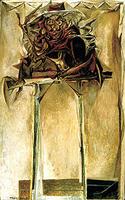Painters Eleven was an influential artists’ group from Toronto in the 1950s that helped introduce abstract painting of a kind then popular in New York into the mainstream of Canadian art.
Beginnings
Painters Eleven dates from 1953 when a group of young artists —Jack Bush, Oscar Cahén, Hortense Gordon, Thomas Hodgson, Alexandra Luke, J.W.G. ("Jock") Macdonald, Ray Mead, Kazuo Nakamura, William Ronald, Harold Townand Walter Yarwood — banded together with the purpose of exhibiting abstract art in Toronto.
By the late 1940s, the Automatistes in Montréal, which included such prominent painters as Paul-Émile Borduas and Jean-Paul Riopelle, and the abstract expressionists in New York had developed a new artistic vocabulary. Toronto in 1950 was still dominated by the Group of Seven. The first public exhibition of abstract artists in Ontario was organized by Luke in 1952 and included nine of the future members of Painters Eleven.
The group came together in the fall of 1953 as a result of the Abstracts at Home exhibition organized by Ronald at the Robert Simpson department store. Assembling for publicity photographs, the seven artists represented — Bush, Cahén, Hodgson, Luke, Mead, Nakamura and Ronald — decided to meet again at Luke's Oshawa, Ontario, studio to discuss their common interests in abstraction. With the addition of Macdonald, Town, Yarwood and Gordon to the group, Town proposed the name Painters Eleven. Bush undertook to approach his dealer about a group exhibition, which the members agreed to finance. In February 1954, the first exhibition of Painters Eleven opened at the Roberts Gallery, drawing large crowds but few sales. Annual exhibitions were held at the Roberts Gallery in 1955 and 1956 and the Park Gallery in 1957 and 1958. A high point came in 1956, when Painters Eleven gained international recognition as guest exhibitors with the American Abstract Artists organization in New York City. Exhibitions organized by regional galleries and the National Gallery of Canada circulated through Canada from 1957 to 1961.
Disbanding and Legacy
Painters Eleven promoted no single vision of the nature of abstraction. In a 1955 exhibition brochure, the group wrote:
There is no manifesto here for the times. There is no jury but time. By now there is little harmony in the noticeable disagreement. But there is a profound regard for the consequences of our complete freedom.
Although Macdonald had explored abstraction as early as 1934, the majority of the group (many a generation younger) became aware of it more than 10 years later, some of them through his teaching. Their sources were varied: Mead trained in England, Cahén in Europe, and Luke, Gordon, Macdonald and Ronald travelled to the United States to study with prominent German-born painter and teacher Hans Hofmann. Though the New York school provided an important example for the group, they developed their own vocabularies and expressive forms.
Critical response in Toronto initially ranged from bewilderment to hostility, but gradually, reviews became more favourable.Robert Fulford gave important press support, and international critics such as Sir Herbert Read (Britain) and Clement Greenberg (United States) praised their work. The 1958 Park Gallery exhibition was the last annual group show: Cahén had died tragically in 1956; Mead had moved to Montréal in 1957, and Ronald had already resigned from the group. In 1960, Painters Eleven voted to disband. Their goals had been achieved, commercial and public galleries exhibited their work, and they had become recognized leaders in the local art scene. The National Gallery of Canada, the Art Gallery of Ontario and the Robert McLaughlin Gallery in Oshawa, Ontario, hold important collections of their work.

 Share on Facebook
Share on Facebook Share on X
Share on X Share by Email
Share by Email Share on Google Classroom
Share on Google Classroom




